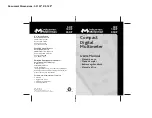
2.40
Do not use the meter if it does not appear to work correctly on all
ranges and in all modes.
2.41
Do not use the meter if it has undergone long-term storage under
unfavorable conditions.
2.42
Do not use the meter if it may have been damaged in transport.
2.43
Always connect one of the meter’s alligator clips to the low side of a
power circuit first. Never clamp onto a hot wire first, (usually red,
black, or blue in AC wiring circuits.) If you clamp onto a hot wire
first, and touch the other probe, you could receive a shock.
2.44
To avoid damage to the meter and possible user injury, disconnect test
leads from test points before changing the function/range.
2.45
Avoid usage near strong magnetic fields (magnets, loudspeakers,
transformers, motors, coils, relays, contactors, electromagnets, etc.).
The meter may display readings that are in error, causing the user to
misinterpret the hazards present. For example, the meter may indicate
a low voltage when high voltages are actually present.
2.46
Avoid usage near strong electrostatic fields (high voltage power lines,
televisions, computer monitors, etc.). The meter may display readings
that are in error, causing the user to misinterpret the hazards present.
For example, the meter may indicate a low voltage when high
voltages are actually present.
2.47
Avoid usage near strong RF fields (radio or television transmitters,
walkie talkies, cellular phones, etc.). The meter may display readings
that are in error, causing the user to misinterpret the hazards present.
For example, the meter may indicate a low voltage when high
voltages are actually present.
2.48
The LCD can be damaged by prolonged exposure to intense sunlight
or to high temperatures. Avoid using or storing the meter under such
conditions.
2.49
When replacing the battery, dispose of the depleted battery in
accordance with any prevailing safety or environmental regulations.
6
3:
INTERNATIONAL SYMBOLS
Содержание 1101-A
Страница 1: ...TRIPLETT MODEL 1101 A 1...
Страница 24: ...24...







































